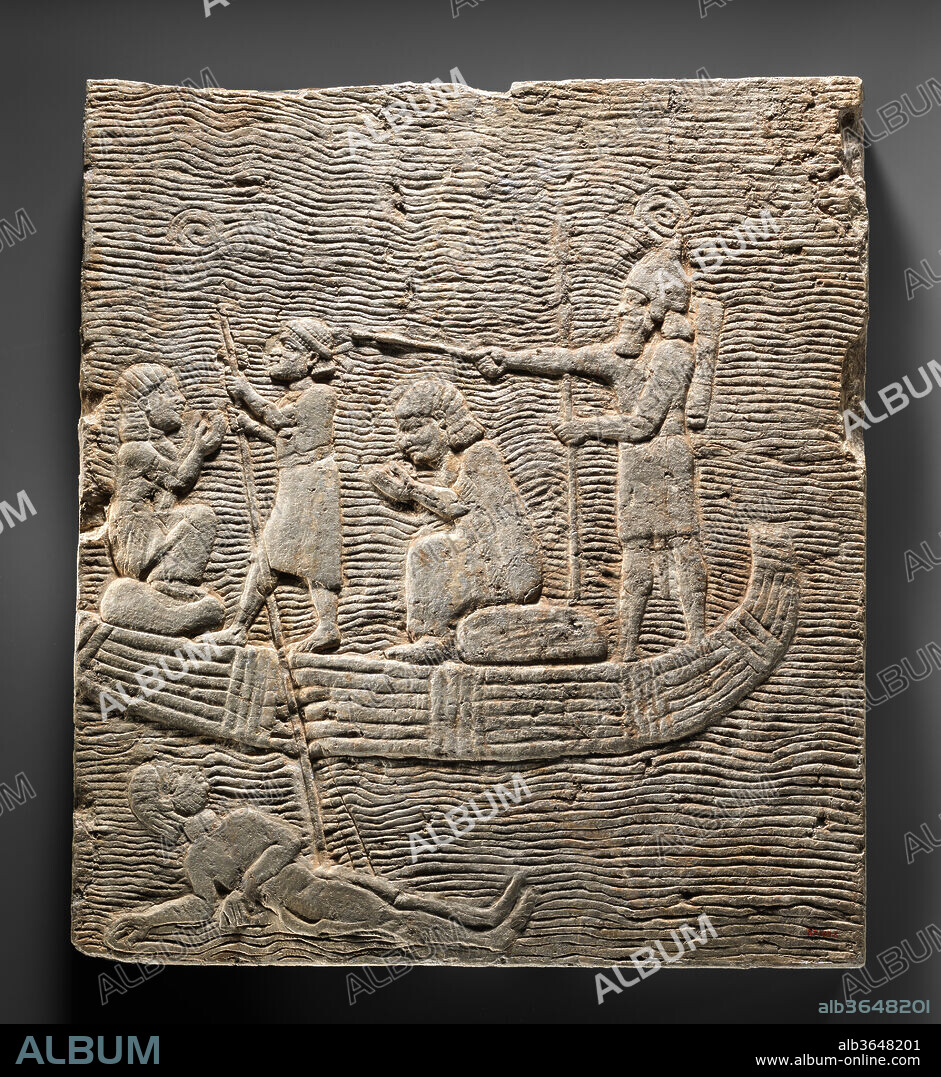alb3648201
Relief fragment: Assyrian soldier conducting captives across the water

|
Add to another lightbox |
|
Add to another lightbox |



Title:
Relief fragment: Assyrian soldier conducting captives across the water
Caption:
Relief fragment: Assyrian soldier conducting captives across the water. Culture: Assyrian. Dimensions: 20 1/4 x 18 1/4 in., 48lb. (51.6 x 46.3 cm)
48 lbs. Date: ca. 668-627 B.C..
This relief fragment comes from a palace at the Assyrian capital of Nineveh in northern Iraq, and dates to the later years of the Assyrian empire, specifically the reign of Ashurbanipal (r. 668-627 B.C.). Originally part of a much larger scene, it shows one of the many small vignettes that characterized Assyrian depictions of military campaigns.
The relief shows a long, narrow reed boat, at the stern of which stands an Assyrian soldier. This bearded figure wears a conical helmet with cheek-guards, as well as greaves to protect his legs, but not body armor such as a cuirass; instead he wears the tunic and wrap commonly worn by most Assyrian men. On his back he carries a quiver for arrows, and though here no bow is visible, other reliefs show that this was also worn on the back. In his left hand he holds a long spear, which the sculptor has depicted as unnaturally passing behind his right arm in order to show both arms as complete. In his right hand the soldier holds a shorter stick, which he apparently uses to direct the much smaller figure propelling the boat with a pole. This figure, also male and bearded, has the dress and hairstyle normally associated in Assyrian art with Elam, a state in southwestern Iran against whom Ashurbanipal fought several wars, and helps to establish the probable location depicted: marshlands also existed in neighboring southern Iraq, but probably the area depicted here is within Elamite territory. The other two figures in the boat are women, both also probably Elamite. They sit on bundles, possibly cushions filled with dry plant matter, though they might instead be bags containing their belongings. Both make a distinctive gesture, raising both open hands with palms toward the face. Seen in several depictions of seated captives, it seems intended to show the sorrow and despair of prisoners.
In the lower part of the panel, the pole used to propel the boat appears to hit a dead body in the water. Assyrian campaign reliefs are unflinching in their depiction of the enemy dead. Assyrian soldiers, by contrast, are never shown being harmed. This absence is more than simple imperial bombast: in the ancient Near East the creation of images was commonly understood to hold real supernatural power. If depicting victory and enemy losses reinforced the empire's power, so depicting Assyrian deaths might risk bringing them about. Assyrian campaign reliefs thus always show total Assyrian dominance. In reality, the marshes were an area where that dominance, based on superiority in open battle and expertise in siege warfare, was largely lost as the Assyrian army was forced to fight elusive enemies in a difficult and unfamiliar environment.
The background of the fragment shows only swirling water, but the boat confirms that the scene is set in marshlands. Small, slender and maneuverable, boats of this kind are ideal for use in the channels running through the marshes, and their reed construction is carefully shown in the depictions by Assyrian artists, to whom they were foreign. The technology has survived, and boats of the same kind are still used in the marshes of southern Iraq today.
Personalities:
Technique/material:
Gypsum alabaster
Period:
NEO-ASSYRIAN
Museum:
Metropolitan Museum of Art, New York, USA
Credit:
Album / Metropolitan Museum of Art, NY
Releases:
Model: No - Property: No
Rights questions?
Rights questions?
Image size:
3859 x 4200 px | 46.4 MB
Print size:
32.7 x 35.6 cm | 12.9 x 14.0 in (300 dpi)
Keywords:
ALABASTER • ANCIENT NEAR EASTERN ART • ASIA • ASSYRIAN • FRAGMENTS • GYPSUM ALABASTER • GYPSUM • IRAQ • MESOPOTAMIA, NINEVEH • METROPOLITAN MUSEUM OF ART, NEW YORK, USA • NEO-ASSYRIAN • NINEVEH • RELIEFS • ROCK • ROCKY • SCULPTURE • STONE • STONE-RELIEFS • STONES
 Pinterest
Pinterest Twitter
Twitter Facebook
Facebook Copy link
Copy link Email
Email

